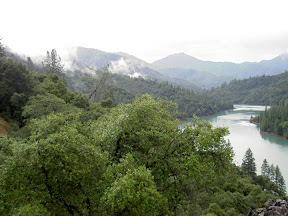
22 July 2007
Well, we finished excavating and sieving and closed up the pit (at least temporarily)! We had quite an interesting last week. We got some visitors to our sieving site last week from a houseboat that was docked nearby. There were quite a few kids and they were very interested in the bones and the sieving process. It was very fun to show them what we do and they even helped us find bones on the sieves. We also had some visits (to our neck of the woods, not to use personally) from DEA agents looking for marijuana plantations. It's not every day you can follow humvees full of men in camoflauge holding machine guns on your way to work! In the middle of this, we also saw a wakeboarding video being filmed right in front of us. It was great to see some top wakeboarders, but after a while the boat wakes and the helicopter noise from the camera crews got to be tiresome.
 Luckily, the middle and end of the week was quiet and fun. We got a lot of rain, with lightening and thunder, on Wednesday, so Ronny, Xue and I drove up to the town of McCloud to see the upriver portion of the McCloud arm of Lake Shasta. We stopped at Castle Crags State Park on our way back and did a quick hike. It would be great to go back to CCSP for a full day because it seems like a great park! On Thursday, an intern with the Forest Service Public Affairs Office joined us for the day- he is planning on writing an article about what we are doing. Finally, on Friday we closed up the pit and finished sieving! (Here's a photo of me coming out of the cave for the final time this season) It was quite a long and momentous day.
Luckily, the middle and end of the week was quiet and fun. We got a lot of rain, with lightening and thunder, on Wednesday, so Ronny, Xue and I drove up to the town of McCloud to see the upriver portion of the McCloud arm of Lake Shasta. We stopped at Castle Crags State Park on our way back and did a quick hike. It would be great to go back to CCSP for a full day because it seems like a great park! On Thursday, an intern with the Forest Service Public Affairs Office joined us for the day- he is planning on writing an article about what we are doing. Finally, on Friday we closed up the pit and finished sieving! (Here's a photo of me coming out of the cave for the final time this season) It was quite a long and momentous day. And now, I'm back home. It was quite a feat to pack everything into the truck. All of our stuff barely fit, but luckily we were able to close all the doors and made our way home safely. Now it's time for the identification to start!
















